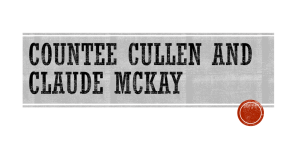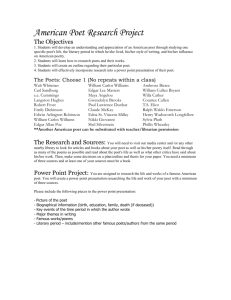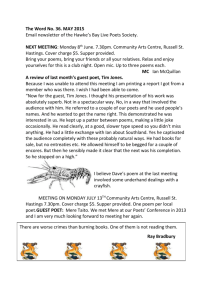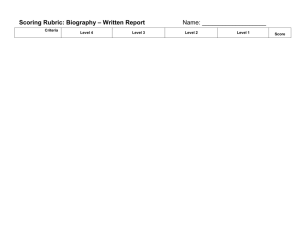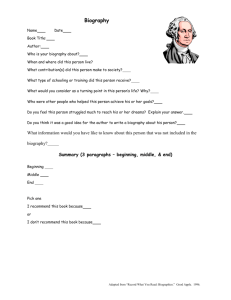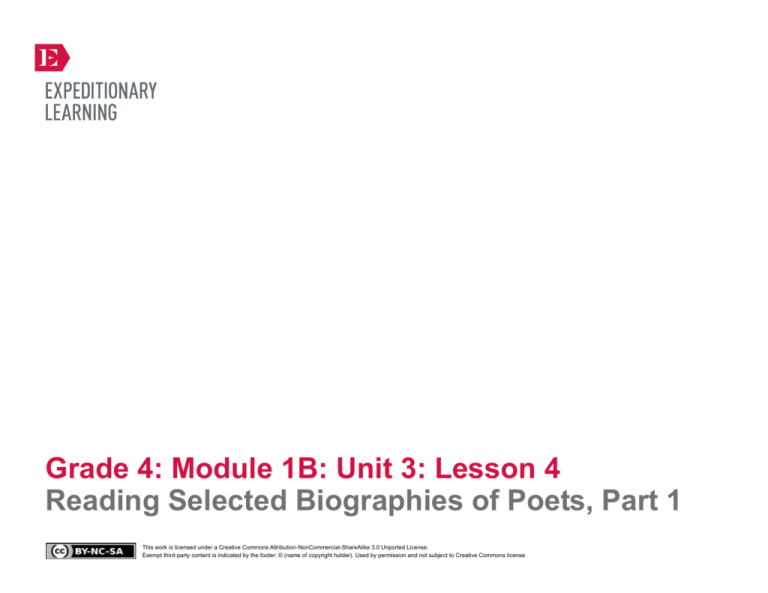
Grade 4: Module 1B: Unit 3: Lesson 4
Reading Selected Biographies of Poets, Part 1
This work is licensed under a Creative Commons Attribution-NonCommercial-ShareAlike 3.0 Unported License.
Exempt third-party content is indicated by the footer: © (name of copyright holder). Used by permission and not subject to Creative Commons license.
GRADE 4: MODULE 1B: UNIT 3: LESSON 4
Reading Selected Biographies of Poets, Part 1
Long-Term Targets Addressed (Based on NYSP12 ELA CCLS)
I can explain what a text says using specific details from the text. (RI.4.1)
I can make inferences using specific details from the text. (RI.4.1)
I can determine the main idea using specific details from the text. (RI.4.2)
I can explain the main points in a historical, scientific, or technical text, using specific details in the text. (RI.4.3)
Supporting Learning Targets
Ongoing Assessment
• I can determine the gist of my poet’s biography.
• Biography of Poet Gist recording form
• I can use evidence from my poet’s biography to answer questions.
• Biography of Poet text-dependent questions
• I can determine the main idea of an excerpt of text.
• Exit ticket
Copyright © 2013 by Expeditionary Learning, New York, NY. All Rights Reserved.
NYS Common Core ELA Curriculum • G4:M1B:U3:L4 • June 2014 •
1
GRADE 4: MODULE 1B: UNIT 3: LESSON 4
Reading Selected Biographies of Poets, Part 1
Agenda
Teaching Notes
1. Opening
• In this lesson, students are introduced to biographies of their selected poets. Students will work in a new
“poet group” of three or four, based on the poet they selected. (Depending on your class size, you may
have as many as three or four groups for a given poet). In these “poet groups,” students will read the
biography for gist and then answer text-dependent questions, giving them an opportunity to gain a
deeper understanding of the text’s meaning.
A. Engaging the Reader (10 minutes)
B. Reviewing Learning Targets (5 minutes)
2. Work Time
A. Finding the Gist: Biographies of Poets (10 minutes)
B. Biography of Poet Text-Dependent Questions (30
minutes)
3. Closing and Assessment
A. Exit Ticket (5 minutes)
4. Homework
A. After reading your poet’s biography, record two
questions you now have about your poet.
B. Continue reading your independent reading book.
• If you have a single student in your class who was the only one to select a particular poet, place this
student in a group reading about a different poet. Students will still be able to support one another since
the task for each text is similar.
• The Gist recording forms and text-dependent questions are specific for the biography of each poet;
however, the directions are the same for all students.
• The Walter Dean Myers biography isn’t paragraphed in the same way the other two are. Therefore, on
the Poetry Gist recording form: Walter Dean Myers, the text has been broken into sections. Consider
marking each section on the text to help students record the gist.
• Most of the unfamiliar vocabulary in the biographies cannot be understood from context. Because
students read their biographies in groups (rather than during whole-group instruction guided by the
teacher in this lesson), definitions have been called out in the text-dependent questions when unfamiliar
vocabulary is necessary to understanding the text and answering the questions.
• The lesson opens with a Carousel of Poets. Use the biographies of poets included in this lesson and the
poems by those poets that students studied in Unit 2 to create a gallery of nine resources. The purpose
of this carousel is to pique students’ interest in the lives of their poets prior to reading the biographies.
For more information, see the “In advance” section below.
• In advance:
– Make a list of which poet each student has selected and post this for students. This way if students
become confused at the end of the Carousel of Poets, you can guide them to which poet they chose.
– On the Walter Dean Myers biography, mark sections of text according to the Poetry Gist recording
form: Walter Dean Myers.
Copyright © 2013 by Expeditionary Learning, New York, NY. All Rights Reserved.
NYS Common Core ELA Curriculum • G4:M1B:U3:L4 • June 2014 •
2
GRADE 4: MODULE 1B: UNIT 3: LESSON 4
Reading Selected Biographies of Poets, Part 1
Agenda
Teaching Notes (continued)
– Prepare resources for the Carousel of Poets:
• A picture of each poet (see Unit 1, Lesson 1)
• A poem from each poet (see Unit 2, Lesson 8)
– Part of each of the biographies of poets—a significant sentence about what inspired them to write
poetry, or about the poetry awards they received (see supporting materials)
– Post: Learning targets.
Lesson Vocabulary
Materials
biography
• Carousel of Poets resources (see Teaching Notes above)
Robert Frost: world-renowned, rural,
precise meters, conversation,
conversational style
• Carousel of Poets note-catcher (one per student)
• Biographies of selected poets
– “Robert Frost (March 26, 1874 – January 29, 1963)” (one per student in Robert Frost group(s))
Valerie Worth: on the side, free verse
– “Valerie Worth (October 29, 1933 – July 31, 1994)” (one per student in Valerie Worth group(s))
Walter Dean Myers: impediment,
diversity
– “Finding Your Voice” (one per student in Walter Dean Myers group(s))
• Biography of Poet Gist recording form (one pertaining to the selected poet per student)
• Biography of Poet Gist recording form (answers, for teacher reference)
• Biography of Poet Text-Dependent Questions (one pertaining to the selected poet per student)
• Biography of Poet Text-Dependent Questions (answers, for teacher reference)
• Exit ticket (one per student)
• Homework: Further Questions (one per student)
Copyright © 2013 by Expeditionary Learning, New York, NY. All Rights Reserved.
NYS Common Core ELA Curriculum • G4:M1B:U3:L4 • June 2014 •
3
GRADE 4: MODULE 1B: UNIT 3: LESSON 4
Reading Selected Biographies of Poets, Part 1
Opening
Meeting Students’ Needs
A. Engaging the Reader: Carousel of Poets (10 minutes)
• Focus students on the Carousel of Poets resources posted around the room.
• Consider pairing up struggling
writers to orally process their
notices and likes rather than
requiring them to write. Or invite
struggling writers to record key
words and phrases rather than
sentences on their note-catcher.
• Display and distribute Carousel of Poets note-catcher. Read through the headings on the note-catcher and explain that
students will record the name of the resource in the first column and their notices and/or likes in the second column.
• Model this with one of the resources. Provide students with ideas of things they may like; for example, vivid words or rhyme.
• Tell students that they should record a notice and/or like for each of the resources they visit.
• Give students 5 minutes to circulate and make notes.
• Refocus whole group and invite volunteers to share one of their notices/likes with the whole group.
• Invite students to go and stand next to their selected poet poster.
• Invite the poet group to discuss:
* “Why are you inspired by this poet’s writing?”
• Select volunteers to share their response whole group.
Copyright © 2013 by Expeditionary Learning, New York, NY. All Rights Reserved.
NYS Common Core ELA Curriculum • G4:M1B:U3:L4 • June 2014 •
4
GRADE 4: MODULE 1B: UNIT 3: LESSON 4
Reading Selected Biographies of Poets, Part 1
Meeting Students’ Needs
Opening (continued)
B. Reviewing Learning Targets (5 minutes)
• Invite students to sit with their poet group (3-4 students per group based on their selected poet –see Teaching Notes).
• Focus students’ attention on the learning targets:
* I can determine the gist of my poet’s biography.
* I can use evidence from my poet’s biography to answer questions.
* I can determine the main idea of an excerpt of text.
• Invite students to read the first learning target with you. Remind them that the gist is what the text is mostly about; so far in
this unit, they have found the gist of the narrative in A River of Words: the Author’s Note.
• Underline the word biography. Ask students to review the meaning of this word with an elbow partner:
* “What is a biography?”
• Cold call students to share their responses. Listen for the definition of biography as the story of someone’s life written by
someone else.
• Invite students to read the second learning target with you.
• Tell students that today they will read biographies of their selected poets.
• Invite them to read the third learning target with you and remind them that the main idea is the point the author is trying to
make.
Copyright © 2013 by Expeditionary Learning, New York, NY. All Rights Reserved.
NYS Common Core ELA Curriculum • G4:M1B:U3:L4 • June 2014 •
5
GRADE 4: MODULE 1B: UNIT 3: LESSON 4
Reading Selected Biographies of Poets, Part 1
Work Time
Meeting Students’ Needs
A. Finding the Gist: Biographies of Poets (10 minutes)
• Place students in their poet groups (see Teaching Notes).
• Consider allowing struggling writers
to record key words or bulleted
phrases instead of complete
sentences for the gist.
• Distribute the biographies to the poet groups.
– “Robert Frost (March 26, 1874 – January 29, 1963” (one per student in Robert Frost group(s))
– “Valerie Worth (October 29, 1933 – July 31, 1994)” (one per student in Valerie Worth group(s)), and
– “Finding Your Voice” (one per student in Walter Dean Myers group(s))
• Also distribute the Biography of Poet Gist recording form to all groups.
• Read through the directions at the top of the recording form aloud and invite students to read along silently.
• Circulate to support students as they find the gist. Ask students:
* “What is the paragraph mostly about?”
• Refer to the Biography of Poet Gist recording form (answers, for teacher reference) for each poet’s biography as
you circulate to guide students.
B. Biography of Poet Text-Dependent Questions (30 minutes)
• Distribute Biography of Poet Text-Dependent Questions.
• Tell students that they are now going to work in groups to dig deeper into their text by answering questions.
• Read the directions at the top of the question sheets aloud (the directions are the same for each biography). Emphasize the
direction at the top of the column on the right that students are to use evidence from the text to support their answers.
• Circulate to support groups in answering text-dependent questions. Frequently remind students to use evidence from the
text to support them in answering the questions.
• Encouraging students to share with
a partner or whole group before
asking them to record their answers
can help to ensure that all students
understand the question and
meaning of the text being closely
read.
• Refer to the Biography of Poet Text-Dependent Questions (answers, for teacher reference) for each poet’s
biography as you circulate to guide students.
• Collect student work at the end of the allocated time for informal assessment. See Teaching Notes for more information.
Copyright © 2013 by Expeditionary Learning, New York, NY. All Rights Reserved.
NYS Common Core ELA Curriculum • G4:M1B:U3:L4 • June 2014 •
6
GRADE 4: MODULE 1B: UNIT 3: LESSON 4
Reading Selected Biographies of Poets, Part 1
Closing and Assessment
Meeting Students’ Needs
A. Exit Ticket (5 minutes)
• Distribute the exit ticket. Tell students that they are going to list three important things they now know about their poet’s
life. Invite students to consider what three things they might tell someone who knows nothing about the poet to give them an
idea of his/her life story.
• Consider grouping struggling
writers with you to orally list three
important things they now know
about their poet’s life.
• Distribute Homework: Further Questions. Read the directions aloud for students.
Homework
Meeting Students’ Needs
• After reading your poet’s biography, record two questions you now have about your poet.
• To provide an extension for
students who are interested or need
further challenge, have students
conduct additional research on their
poet online (for Valerie Worth and
Walter Dean Myers) or by reading
an additional biography (Robert
Frost –see Unit 3 Rec0mmended
text list).
• Continue reading your independent reading book.
Copyright © 2013 by Expeditionary Learning, New York, NY. All Rights Reserved.
NYS Common Core ELA Curriculum • G4:M1B:U3:L4 • June 2014 •
7
Grade 4: Module 1B: Unit 3: Lesson 4
Supporting Materials
This work is licensed under a Creative Commons Attribution-NonCommercial-ShareAlike 3.0 Unported License.
Exempt third-party content is indicated by the footer: © (name of copyright holder). Used by permission and not subject to Creative Commons license.
GRADE 4: MODULE 1B: UNIT 3: LESSON 4
Carousel of Poets Note-catcher
Name:
Date:
Directions: Record something you notice or something you like for each of the resources you visit.
Name of Resource
Copyright © 2013 by Expeditionary Learning, New York, NY. All Rights Reserved.
Notices or Likes
NYS Common Core ELA Curriculum • G4:M1B:U3:L4 • June 2014 •
9
GRADE 4: MODULE 1B: UNIT 3: LESSON 4
Carousel of Poets Note-catcher
Name of Resource
Copyright © 2013 by Expeditionary Learning, New York, NY. All Rights Reserved.
Notices or Likes
NYS Common Core ELA Curriculum • G4:M1B:U3:L4 • June 2014 •
10
GRADE 4: MODULE 1B: UNIT 3: LESSON 4
Robert Frost
(March 26, 1874 – January 29, 1963)
By Jayson Fleischer. Copyright © 2014 by the American Reading Company
Copyright © American Reading Company 2014
NYS Common Core ELA Curriculum • G4:M1B:U3:L4 • June 2014 •
11
GRADE 4: MODULE 1B: UNIT 3: LESSON 4
Valerie Worth
(October 29, 1933 – July 31, 1994)
By Jayson Fleischer and Megan Roszkowski. Copyright © 2014 by the American Reading Company
Copyright © American Reading Company 2014
NYS Common Core ELA Curriculum • G4:M1B:U3:L4 • June 2014 •
12
GRADE 4: MODULE 1B: UNIT 3: LESSON 4
“Finding Your Voice”
(Biography of Walter Dean Myers)
Copyright © Scholastic Inc. Used by permission and not subject to Creative Commons
license.
NYS Common Core ELA Curriculum • G4:M1B:U3:L4 • June 2014 •
13
GRADE 4: MODULE 1B: UNIT 3: LESSON 4
“Finding Your Voice”
(Biography of Walter Dean Myers)
From Scholastic News, April 4, 2005. Copyright © 2005 by Scholastic Inc. Reprinted by permission of Scholastic Inc.
Copyright © Scholastic Inc. Used by permission and not subject to Creative Commons
license.
NYS Common Core ELA Curriculum • G4:M1B:U3:L4 • June 2014 •
14
GRADE 4: MODULE 1B: UNIT 3: LESSON 4
Biography of Poet Gist Recording Form:
Robert Frost
Name:
Date:
Directions:
1. Read the biography all the way through as a group. Decide who will read which paragraphs aloud
as the rest of the group follows along silently.
2. Work together as a group to find the gist of each paragraph.
3. Record the gist of each paragraph on your Biography of Poet Gist recording form.
Paragraph
Number
Gist (what is your initial sense of what the paragraph is mostly about?)
1.
2.
3.
4.
Copyright © 2013 by Expeditionary Learning, New York, NY. All Rights Reserved.
NYS Common Core ELA Curriculum • G4:M1B:U3:L4 • June 2014 •
15
GRADE 4: MODULE 1B: UNIT 3: LESSON 4
Biography of Poet Gist Recording Form:
Valerie Worth
Name:
Date:
Directions:
4. Read the biography all the way through as a group. Decide who will read which paragraphs aloud
as the rest of the group follows along silently.
5. Work together as a group to find the gist of each paragraph.
6. Record the gist of each paragraph on your Biography of Poet Gist recording form.
Paragraph
Number
Gist (what is your initial sense of what the paragraph is mostly about?)
1.
2.
3.
4.
Copyright © 2013 by Expeditionary Learning, New York, NY. All Rights Reserved.
NYS Common Core ELA Curriculum • G4:M1B:U3:L4 • June 2014 •
16
GRADE 4: MODULE 1B: UNIT 3: LESSON 4
Biography of Poet Gist recording form:
Walter Dean Myers
Name:
Date:
Directions:
1. Read the biography all the way through as a group. Decide who will read which paragraphs aloud as the rest
of the group follows along silently.
2. Work together as a group to find the gist of each paragraph.
3. Record the gist of each paragraph on your Biography of Poet Gist recording form.
Section
Gist (what is your initial sense of what this section is mostly about?)
1. Up to, “… it would
officially be
considered a
poem.”
2. Giving Voice to
Many
3. Poetry Today
Copyright © 2013 by Expeditionary Learning, New York, NY. All Rights Reserved.
NYS Common Core ELA Curriculum • G4:M1B:U3:L4 • June 2014 •
17
GRADE 4: MODULE 1B: UNIT 3: LESSON 4
Biography of Poet Gist Recording Form: Robert Frost
(Answers, for Teacher Reference)
Paragraph
Number
Gist (what is your initial sense of what the paragraph is mostly about?)
1.
Robert Frost was born in California in 1874 and had published his first
poem in his high school magazine. He got married, but never graduated
from college.
2.
He was inspired by the countryside and wrote many poems on the farm
that he and Elinor bought. They moved to England where he had a book
published, but headed back to the United States after World War I broke
out.
3.
When Frost was alive, poetry was changing from traditional poetry to
modern poetry. Frost was neither traditional nor modern.
4.
Frost won many awards and read a poem at the inauguration of
President John F. Kennedy. He died in 1962.
Copyright © 2013 by Expeditionary Learning, New York, NY. All Rights Reserved.
NYS Common Core ELA Curriculum • G4:M1B:U3:L4 • June 2014 •
18
GRADE 4: MODULE 1B: UNIT 3: LESSON 4
Biography of Poet Gist Recording Form: Valerie Worth
(Answers, for Teacher Reference)
Paragraph
Number
Gist (what is your initial sense of what the paragraph is mostly about?)
1.
Valerie Worth was born and raised in Pennsylvania, but moved to
Tampa and then India. She returned to Pennsylvania to go to college, got
married, and wrote poetry as a hobby.
2.
Worth read some of her poems to a group that included author and
illustrator Natalie Babbitt. Natalie sent Valerie’s poems to her publisher,
and she and Valerie became such good friends that Natalie illustrated
Valerie’s first published book of poetry.
3.
Valerie Worth loved nature and wrote simple free-verse poems about
nature, ordinary events, and objects.
4.
Valerie and her husband had three children and published many books
that were illustrated by Natalie Babbitt. She received an award for her
poetry and died in 1994.
Copyright © 2013 by Expeditionary Learning, New York, NY. All Rights Reserved.
NYS Common Core ELA Curriculum • G4:M1B:U3:L4 • June 2014 •
19
GRADE 4: MODULE 1B: UNIT 3: LESSON 4
Biography of Poet Gist Recording Form: Walter Dean Myers
(Answers, for Teacher Reference)
Section
4. Up to, “… it
would officially
be considered a
poem.”
5. Giving Voice to
Many
Gist (what is your initial sense of what this section is mostly about?)
Walter Dean Myers had difficulty speaking, but he found poetry
helped him to speak because the rhyme and rhythm helped him and
he chose words he could pronounce easily.
Walter Dean Myers grew up in Harlem in New York City and uses
poetry to show the beauty of the city.
Kids today understand poetry because of hip-hop. Poetry gives them
an appreciation of language.
6. Poetry Today
Copyright © 2013 by Expeditionary Learning, New York, NY. All Rights Reserved.
NYS Common Core ELA Curriculum • G4:M1B:U3:L4 • June 2014 •
20
GRADE 4: MODULE 1B: UNIT 3: LESSON 4
Biography of Poet Text-Dependent Questions:
Robert Frost
Name:
Date:
Directions:
1. Read the questions carefully.
2. Refer to the text to find the answers.
3. Use evidence from the text in your answers.
Question
Answer (include evidence from the text)
1. The text says that Robert
Frost became a worldrenowned poet. Worldrenowned means famous
around the world, but
Robert Frosts didn’t start
off famous. When did he
publish his first poem?
2. What caused Robert
Frost to believe that he
may have a career as a
successful poet?
3. Rural means in the
countryside rather than
in the town. What was
Robert Frost inspired by?
Copyright © 2013 by Expeditionary Learning, New York, NY. All Rights Reserved.
NYS Common Core ELA Curriculum • G4:M1B:U3:L4 • June 2014 •
21
GRADE 4: MODULE 1B: UNIT 3: LESSON 4
Biography of Poet Text-Dependent Questions:
Robert Frost
Question
Answer (include evidence from the text)
4. Why did Robert and
Elinor move to England?
5. The text says that
traditional poetry used
precise meters, which are
precise rhythms. In your
own words, explain how
poetry was changing at
the time of Robert Frost?
6. A conversation is when
people speak to each
other. So what do you
think a conversational
style might be in poetry?
7. How was Robert Frost’s
poetry different?
8. What is the main idea of
the final paragraph
beginning with, “In 1924,
Frost won …”?
Copyright © 2013 by Expeditionary Learning, New York, NY. All Rights Reserved.
NYS Common Core ELA Curriculum • G4:M1B:U3:L4 • June 2014 •
22
GRADE 4: MODULE 1B: UNIT 3: LESSON 4
Biography of Poet Text-Dependent Questions:
Valerie Worth
Name:
Date:
Directions:
1. Read the questions carefully.
2. Refer to the text to find the answers.
3. Use evidence from the text in your answers.
Question
Answer (include evidence from the text)
1. On the side means as a
hobby outside of work.
What did Valerie Worth
do on the side when she
worked at Yale University
Press?
2. How did meeting Natalie
Babbitt help Valerie
Worth’s poetry career?
3. What inspired Valerie
Worth?
Copyright © 2013 by Expeditionary Learning, New York, NY. All Rights Reserved.
NYS Common Core ELA Curriculum • G4:M1B:U3:L4 • June 2014 •
23
GRADE 4: MODULE 1B: UNIT 3: LESSON 4
Biography of Poet Text-Dependent Questions:
Valerie Worth
Question
Answer (include evidence from the text)
4. What did she write her
poetry about? Why?
5. Free verse means without
rhyming. How was her
poetry different from that
of many other poets at
the time?
6. What is the main idea of
the final paragraph
beginning with, “Worth
and her husband had
three children …”?
Copyright © 2013 by Expeditionary Learning, New York, NY. All Rights Reserved.
NYS Common Core ELA Curriculum • G4:M1B:U3:L4 • June 2014 •
24
GRADE 4: MODULE 1B: UNIT 3: LESSON 4
Biography of Poet Text-Dependent Questions:
Walter Dean Myers
Name:
Date:
Directions:
1. Read the questions carefully.
2. Refer to the text to find the answers.
3. Use evidence from the text in your answers.
Question
Answer (include evidence from the text)
1. A speech impediment is a
when someone has
difficulty speaking. How
did poetry help Walter
Dean Myers with his
speech impediment?
2. When it says he used
poetry to give the
community, including
kids, “a voice,” what do
you think that means?
3. The text says, “He uses
poetry to showcase the
diversity and beauty of
the city.” Diversity is
when people or things are
different from each other.
Explain in your own
words what this sentence
means.
Copyright © 2013 by Expeditionary Learning, New York, NY. All Rights Reserved.
NYS Common Core ELA Curriculum • G4:M1B:U3:L4 • June 2014 •
25
GRADE 4: MODULE 1B: UNIT 3: LESSON 4
Biography of Poet Text-Dependent Questions:
Walter Dean Myers
Question
Answer (include evidence from the text)
4. How is Walter Dean
Myers’s idea of beauty
different from that of
most people?
5. According to Walter Dean
Myers, what does poetry
give to kids?
6. What is the main idea of
the final paragraph with
the heading “Poetry
Today”?
Copyright © 2013 by Expeditionary Learning, New York, NY. All Rights Reserved.
NYS Common Core ELA Curriculum • G4:M1B:U3:L4 • June 2014 •
26
GRADE 4: MODULE 1B: UNIT 3: LESSON 4
Biography of Poet Text-Dependent Questions: Robert Frost
(Answers, for Teacher Reference)
Question
Answer (include evidence from the text)
1. The text says that Robert Frost became a
world-renowned poet. World-renowned
means famous around the world, but Robert
Frosts didn’t start off famous. When did he
publish his first poem?
Frost published his first poem in his high
school’s magazine in 1890.
2. What caused Robert Frost to believe that he
may have a career as a successful poet?
When he “sold his first poem, ‘My Butterfly:
An Elegy,’ in 1892 to the magazine The
Independent for $15.”
3. Rural means in the countryside rather than
in the town. What was Robert Frost inspired
by?
“He was deeply inspired by the countryside
and culture of the rural northeast.”
4. Why did Robert and Elinor move to
England?
“He hoped to have more luck with English
publishers.”
5. The text says that traditional poetry used
precise meters, which are precise rhythms.
In your own words, explain how poetry was
changing at the time of Robert Frost?
It was changing from traditional to modern
poetry. Traditional uses rhyme, formal and
flowery language, and “heavy themes like
love, beauty, or death.” Modern uses free
verse, was simpler, and is about everyday
topics.
6. A conversation is when people speak to each
other. So what do you think a
conversational style might be in poetry?
A conversational style in poetry is a poem
that sounds like a conversation.
Copyright © 2013 by Expeditionary Learning, New York, NY. All Rights Reserved.
NYS Common Core ELA Curriculum • G4:M1B:U3:L4 • June 2014 •
27
GRADE 4: MODULE 1B: UNIT 3: LESSON 4
Biography of Poet Text-Dependent Questions: Robert Frost
(Answers, for Teacher Reference)
Question
Answer (include evidence from the text)
7. How was Robert Frost’s poetry different?
He wasn’t like traditional poets or modern
poets. “He wrote in a conversational style
and his themes explored nature and daily
life.”
8. What is the main idea of the final paragraph
beginning with, “In 1924, Frost won …”?
Robert Frost was a very successful poet and
won a lot awards for his poetry.
Copyright © 2013 by Expeditionary Learning, New York, NY. All Rights Reserved.
NYS Common Core ELA Curriculum • G4:M1B:U3:L4 • June 2014 •
28
GRADE 4: MODULE 1B: UNIT 3: LESSON 4
Biography of Poet Text-Dependent Questions: Valerie Worth
(Answers, for Teacher Reference)
Question
Answer (include evidence from the text)
1. On the side means as a
hobby outside of work.
What did Valerie Worth
do on the side when she
worked at Yale University
Press?
She “wrote poetry on the side.”
2. How did meeting Natalie
Babbitt help Valerie
Worth’s poetry career?
Natalie Babbitt offered to send Valerie’s poems to her
publisher. She also illustrated some of Valerie’s poetry
books.
3. What inspired Valerie
Worth?
Nature. “She enjoyed being alone with nature and loved to
study the close details of weeds, flowers, and small animals.
She combined her love of poetry and nature in her own
poems.”
4. What did she write her
poetry about? Why?
Everyday things. “She wanted her poetry to show the magic
that can be found in nature and in ordinary events and
objects.”
5. Free verse means without
rhyming. How was her
poetry different from that
of many other poets at
the time?
“While many poets at the time were writing about their
lives, Worth focused her poetry on everyday things. Instead
of writing about important events from her own life, she
explored experiences that all children share.”
6. What is the main idea of
the final paragraph
beginning with, “Worth
and her husband had
three children …”?
Valerie Worth was a very successful poet who published a
lot of books and won an award.
Copyright © 2013 by Expeditionary Learning, New York, NY. All Rights Reserved.
NYS Common Core ELA Curriculum • G4:M1B:U3:L4 • June 2014 •
29
GRADE 4: MODULE 1B: UNIT 3: LESSON 4
Biography of Poet Text-Dependent Questions: Walter Dean Myers
(Answers, for Teacher Reference)
Question
Answer (include evidence from the text)
1. A speech impediment is a when
someone has difficulty
speaking. How did poetry help
Walter Dean Myers with his
speech impediment?
He wrote words he could pronounce easily, and the
rhythm of poetry “carried him through.”
2. When it says he used poetry to
give the community, including
kids, “a voice,” what do you
think that means?
It means he used poetry to help people outside Harlem
understand what life is like for people, including
children, in Harlem.
3. The text says, “He uses poetry
to showcase the diversity and
beauty of the city.” Diversity is
when people or things are
different from each other.
Explain in your own words
what this sentence means.
He uses poetry to show the different types of people
and things in the city and how beautiful the city can be
as a result.
4. How is Walter Dean Myers’s
idea of beauty different from
that of most people?
Most people describe the countryside as beautiful.
Walter Dean Myers thinks things in the city are
beautiful: “The geometry of the buildings were very
comforting to me…. The city is wonderful too.”
5. According to Walter Dean
Myers, what does poetry give to
kids?
“Poetry gives kids an appreciation of language.”
6. What is the main idea of the
final paragraph with the
heading “Poetry Today”?
Poetry can help kids to do interesting and beautiful
things with language.
Copyright © 2013 by Expeditionary Learning, New York, NY. All Rights Reserved.
NYS Common Core ELA Curriculum • G4:M1B:U3:L4 • June 2014 •
30
GRADE 4: MODULE 1B: UNIT 3: LESSON 4
Exit Ticket
Name:
Date:
Directions: List three important things you now know about the life of your poet.
1.
2.
3.
Copyright © 2013 by Expeditionary Learning, New York, NY. All Rights Reserved.
NYS Common Core ELA Curriculum • G4:M1B:U3:L4 • June 2014 •
31
GRADE 4: MODULE 1B: UNIT 3: LESSON 4
Homework: Further Questions
Name:
Date:
Directions: Record two questions you now have about your poet.
1.
2.
Copyright © 2013 by Expeditionary Learning, New York, NY. All Rights Reserved.
NYS Common Core ELA Curriculum • G4:M1B:U3:L4 • June 2014 •
32




